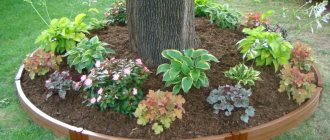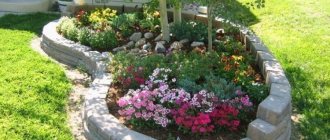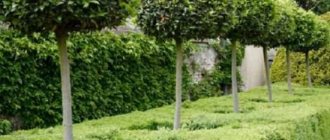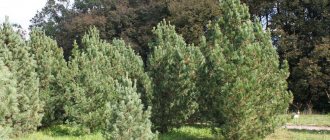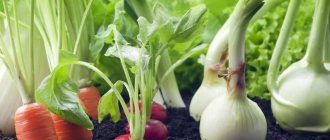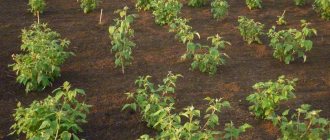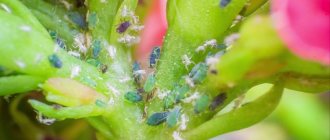Why do you need a trunk circle around a tree in the garden?
Recently, debates have often arisen about the benefits of tree trunk circles around garden trees. Some gardeners claim that they are unnecessary, since in natural conditions trees feel good adjacent to other plants. Others refuse them, believing that tree trunk circles disfigure the lawn in the garden, especially when several trees are planted on the site and all are surrounded by these circles. Let's look into this issue.
When planting a new tree or shrub among already growing plants, the root system of the seedling is not yet strong and it is difficult for it to compete with old plantings for moisture and the soil microelements it needs. Such a seedling needs good conditions for its development: trees are about 2-3 years old, bushes - at least a year. Also, a development problem arises if you decide to surround a fresh seedling with flowers or lawn grass. These “neighbors” develop faster and draw almost all useful substances from the soil, thereby limiting the growth of the seedling.
When it comes time to mow the lawn, gardeners are often faced with the problem of processing the area near the bushes. Their branches often bend towards the ground and need to be constantly lifted while cutting, which is inconvenient. This is where tree trunk circles come to the rescue, making it easier to mow the lawn.
Another advantage of the tree trunk circle is the convenience of applying moisture and fertilizers under the tree. Many gardeners do not plant anything around fruit trees at all, but make the trunk circle in the form of a depression; they are filled with mulch to retain moisture.
You can also watch this video about the benefits of the tree trunk circle
Advantages and disadvantages
Almost any type of such design requires preliminary digging. That’s why some people prefer not to touch this space at all, leaving it in its original form. We have already described all the advantages of such processing above.
What disadvantages can you encounter with such an organization of space? Let's start with the fact that when wielding a shovel, you prevent not only harmful organisms from surviving, but also beneficial ones. Special bacteria, without which the plant cannot absorb nutrients, need air flow.
But when the earth is dug up, these organisms end up at depth. As a result, they cannot survive. One more thing – roots! They are very easy to damage while digging. If you take up this task with the arrival of cold weather, you will expose the roots to more intense exposure to frosty air, and this can be dangerous for them.
If we take non-woven material, then the price of a tree trunk circle with a diameter of one meter will be around 50 rubles. Coconut fiber will cost much more. A fragment of the same size will cost one thousand rubles. If you take spunbond, you will need to pay about 300 rubles for the same dimensions.
Before, I never attached importance to the design of tree trunk circles. I have not yet visited the private park of a famous landscape designer. Today I know: decorating the soil next to a tree trunk can be done with your own hands. This is the most creative work in the garden. I will tell you how to beautifully and usefully arrange tree trunks in the garden.
Determining the diameter of the trunk circle of fruit trees
As soon as a tree is planted in the garden, a trunk circle is formed around it. What size a particular plant needs depends on the main parameter - the crown of the crop and its dimensions. During the first year after planting, this figure should be the same as the diameter of the crown. These parameters will change in the future.
Typically, the dimensions of the designated area do not cover the entire crown projection; it is smaller in size. The minimum acceptable value should be 1.5 meters. Every two years this parameter increases by 50-100 centimeters. The type of tree also matters.
For example, the size of the trunk circle of an apple and pear tree is:
- approximately 2 meters for specimens that are already 1-2 years old;
- about 2.5 meters - for crops up to 4 years old;
- approximately 3 meters for crops that are 5-6 years old;
- 3.5 meters – for 7-8 years of age.
The diameter of the trunk circle of plums and cherries is:
- at least 2 meters for trees that are 1-2 years old;
- about 2.5 meters - for plums, cherries, older than 4 years;
- from 3 meters – for 6-8 year old specimens.
For apricots the parameters are as follows:
- 1.5 meters in diameter - for 1-3 years of age;
- 2 meters – for 4-5 year old crops;
- 3 meters – 6-8 year olds;
- up to 5 meters – for 9 year olds.
Areas for plantings must have a horizontal surface (even on slopes). This is an important point so that water from irrigation and precipitation flows well to the roots and does not drain. For exactly the same reason, minor recesses are made to allow full irrigation.
Basic rules on how to make a tree trunk circle for fruit trees
Despite the fact that there is a huge variety in the design of such an area, several important rules should be followed:
- the root system of any crop needs free space and a sufficient amount of oxygen, thanks to this the plants bear fruit well;
- It is not allowed to block young specimens with various decorative fragments, as this can cause poor development of the crop; during the first 5 years, it is recommended to decorate using organic matter;
- Under mature crops, it is practiced to plant greens - cilantro, parsley, dill; this solution is not the best, since when processing trees, chemicals can get on the greens.
Compliance with these rules will allow you to get healthy plants and a well-groomed, beautiful place on the site.
Design options
There are a lot of decoration methods and options. In this case, be sure to take into account that over time the area will increase, which means that the space will need to continue to be supplemented. Let's look at the most interesting design solutions.
Border for tree trunk circle
Using curb tape is a classic method that is suitable for practical people who want to spend a minimum of effort on maintenance.
Surrounding plantings with such a tape is a fairly practical solution to delimit the lawn surface and the area around the trunk. There is a huge variety of tapes, but it is optimal to choose a smooth, flexible one, the height of which will be no more than 10 centimeters. They even sell special plastic circles , which can also be used to harmoniously complement trees.
Lawn grass in the trunk circle
Sowing a lawn is a good solution, visually beautiful, but it has certain nuances for young plantings, mentioned above.
Turfgrass can be used to complement mature trees without fear of competition between woody and herbaceous crops.
Coconut trunk circle
Coconut fiber is a modern and sought-after choice. Recently, it has become popular because it has a beautiful visual appearance, absorbs moisture quite well, and has bactericidal properties.
This solution is also relevant for crops that prefer soil with a neutral acidity level. You can buy tree trunk circles made from coconut fiber online or at garden centers.
Uses of pine bark
Pine bark is an environmentally friendly and natural material. It helps disinfect the air and improve the aesthetic appearance of the space. Thanks to the formed microclimatic conditions, worms develop under the bark. They help improve soil fertility, breathability and structure.
By mulching the soil with a layer of 5-8 centimeters, you can protect fruit crops from being colonized by cockchafers. Prolonged rains will also not be a problem, since the pine bark prevents excess moisture from entering the soil. The bark also prevents excessive evaporation.
Application of grass clippings
Mown grass is a fairly economical and good way to improve the tree trunk circle with your own hands. This allows not only to rationally use plant residues from lawn mowing, but also to create a protective layer near the crops. Also, this solution neutralizes the process of emergence of weeds. But another plus is that the tree receives natural nutrition.
But when using this method, be careful. The layer of grass should not exceed more than 3 centimeters. Otherwise, putrefactive processes will begin, and this will negatively affect the general state of the culture. It is recommended to mulch with grass once a month, and a layer is laid on top of another only after you are completely sure that the first one has dried.
Plants in the trunk circle
If desired, you can plant strawberries in such space. It has a shallow root system, so it does not harm the trees at all, and weeding the berries will only improve the condition of the adult plant. The main rule is to prevent the development of a dense carpet in the space.
Among flower crops, it is better to give preference to annuals. Since the rhizome of perennial representatives becomes denser over time, which negatively affects the development of crops.
The best solutions would be to use:
- marigolds, especially since they have a specific aroma that repels harmful insects;
- coleus, which has variegated and beautiful multi-colored leaves;
- decorative cabbage, enlivening the autumn garden picture;
- calendula, which has antibacterial properties, drives away caterpillars or slugs from the area.
Beautiful flowers in the tree trunks of fruit trees will look incredibly beautiful and enliven your garden.
Backfilling with gravel and pebbles
This mulch is durable, practical, and very beautiful. It should be laid on agrofibre, and the edges should be secured with borders made of plastic or stone. This will prevent the sprinkles from flying beyond the intended boundaries.
An additional advantage is the huge color palette of the material, which will allow you to create incredible design solutions.
Where to get material for mulch
An effective method of maintaining and keeping plantings healthy is mulching apple trees.
Advantages:
- shelter helps protect the ground from erosion;
- moisture evaporates more slowly from the top layer;
- air exchange improves and the formation of crust on the soil surface is prevented;
- the roots are reliably protected from overheating on hot days, and from freezing in winter;
- good protection against pests;
- mulch is a source of carbon dioxide for the apple tree;
- Thanks to the covering material, beneficial soil flora and fauna increases.
For mulching, simple material is used, which is found in every summer cottage or in the forest. This is the simplest method that does not require material costs. Use:
- cut grass;
- sawdust;
- straw;
- pine and spruce needles;
- tree bark;
- bumps.
To ensure that the mulch not only fulfills its functions, but also has a decorative effect, it is purchased in specialized stores:
- small multi-colored pebbles;
- sea pebbles;
- decorative wood chips;
- special covering material.
Rules for caring for tree trunks
To ensure that the area around the trees does not lose its attractiveness, agrotechnical manipulations should be systematically carried out. We propose to consider each point in detail.
Tillage in tree trunk circles
The main point is the digging. This procedure can be performed both in spring and in summer and autumn. In spring, this accelerates the warming of the soil. After the process has been completed, compost can be placed on top of the ground. It will provide adequate conditions so that the soil warms up well and the root system is saturated with useful substances.
In autumn, you will need to remove any remaining vegetation from the area. You can burn them to prevent diseases and pests from appearing. When digging, the shovel is directed with its edge towards the tree, the plowing depth is up to 15 centimeters. It is recommended to carry out digging 7-10 days before the onset of frost.
In summer, digging up the soil is also practiced, since this is an integral process when fertilizing. Usually the beginning of July is chosen for this.
Loosening the tree trunk circle
Loosening is a procedure that improves the structure of the soil, which allows oxygen to fully reach the root system. During the season, such manipulations are performed 4-5 times. If there is no mulch, you will also need to fight weeds. Loosening is best done at the end of irrigation.
Watering and its features
How much watering will be depends on climatic conditions and the type of plants. In regions with systematic droughts, it is necessary to periodically moisten the soil. This is of particular importance for young trees that have not yet developed a full-fledged root system. Columnar crops and dwarfs with shallow roots also require irrigation.
It is recommended to use up to 3 buckets of water for young plants (up to 1 year), and up to 2 buckets for stone fruit crops. Moistening is not allowed in places where there is already enough moisture. Otherwise, this will lead to rotting of the root system.
Applying fertilizers to the soil
For the full development of crops, it is necessary to apply the optimal amount of fertilizing. Typically, such procedures are carried out not once, but several times per season:
- When performing spring digging, covering up organic matter and minerals with a shovel.
- 2 weeks after flowering ends. Then liquid mineral compounds are added.
- At the beginning and end of summer. First - during the period of ovary filling, and then - at the end of August. In the first case, mineral components are used, in the second - potassium and phosphorus.
The final chord will be feeding during the autumn digging. Experienced gardeners apply fertilizer within the tree trunk circle. It's a matter of the location of the rhizome. It is approximately the same as the crown parameters. Therefore, by adding fertilizers here, you can really provide the crops with the maximum useful components.
One more nuance - before winter it is advisable to bury tree trunk circles if they are below soil level . This is necessary so that melt water does not collect there during a thaw.
If frost strikes again, the water will turn into ice, which will negatively affect the health of fruit trees, especially young seedlings.
Tips for adding mulch
The effectiveness of mulch depends on its correct application, so follow these two recommendations:
- Spread the mulch in a thin (no more than 5-7 cm) layer.
- Renew the mulch material annually, completely removing the old layer, especially around plants prone to disease (such as roses, for example).
The soil covered with mulch does not wash away or become compacted during rains, especially during heavy downpours
Here's what you shouldn't do:
- Do not use grass clippings as mulch if they have been treated with pesticides within the last 30 days. Caustic substances can damage other plants in the garden;
- do not add fresh compost as mulch - it can “burn” sensitive plants and young seedlings;
- Do not mulch plants in early spring. If the soil has not yet thawed, the mulch layer will slow down the growth and development of plants;
- Don't make a mound out of mulch. Plants surrounded by “mulch volcanoes” will suffer from excess moisture and become easy prey for diseases and pests.
So, now you know everything about the types of mulch and its combination with various plantings and decorative elements of the site. Armed with this knowledge, you can confidently begin creating the garden of your dreams.
